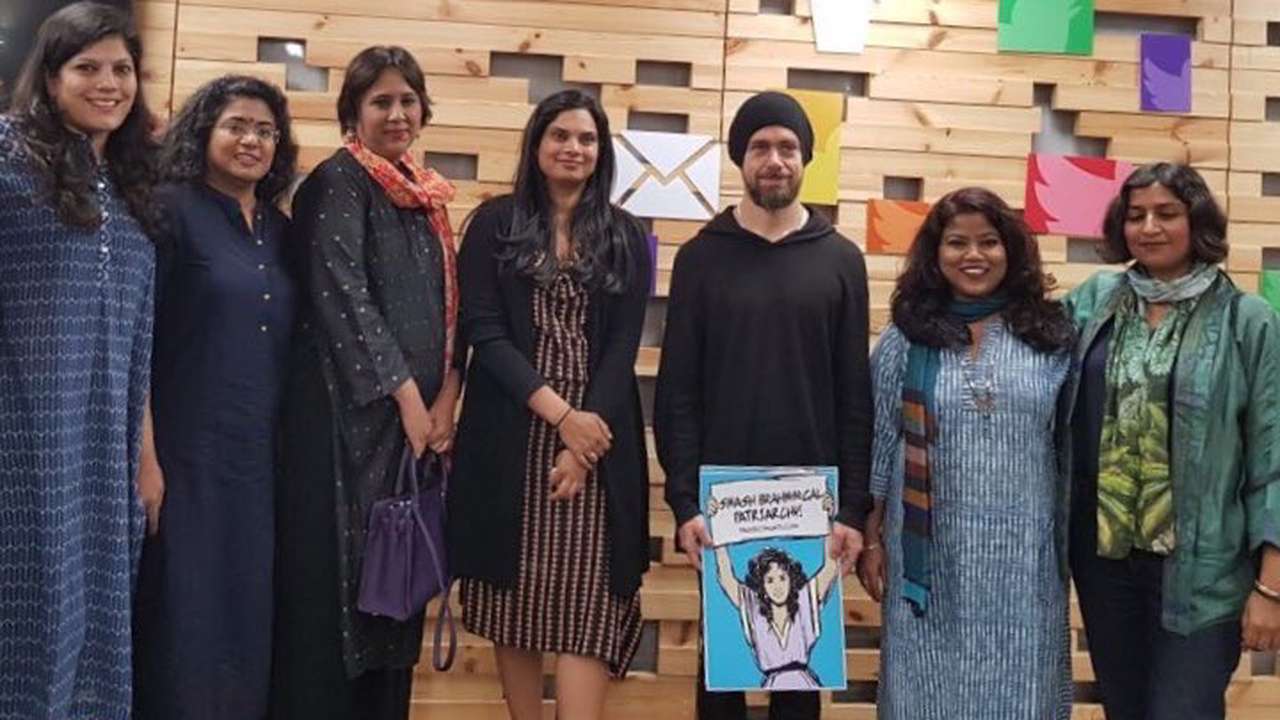Twitter CEO Jack Dorsey’s India trip was expected to generate some controversy, given how he was given a frosty welcome by certain sections of his userbase, and it hasn’t disappointed.
Dorsey is getting slammed on Twitter for holding up a placard that says “Smash Brahminical patriarchy”. A photo with Dorsey holding up the placard surfaced on Twitter, where he was flanked by media persons and activists including Barkha Dutt . It’s unclear whether Dorsey — who has previously shown an interest in Indian culture, having completed a Vipassana course last year — understands enough about Brahminism in order to want to smash it, but Twitter was quick to pounce.
“What a shame; How can people put such a hate poster and malign a community. How can you as CEO of Twitter be party to this kind of hate? Shocking; this is Brahmin-phobia of the worst kind,” wrote former Infosys CFO Mohandas Pai.
What a shame; How can people put such a hate poster and malign a community: @jack How can you as ceo of @twitter be party to this kind of hate? Shocking; this is @brahminphobia of the worst kind https://t.co/bWU0eBo9yG
— Mohandas Pai (@TVMohandasPai) November 19, 2018
Dorsey’s anti-Brahmin posturing didn’t go down well with other entrepreneurs as well. Anand Lunia of India Quotient hinted that Dorsey was peddling a far-left agenda, and would perhaps use his platform to push it. Twitter is one of India’s most politically-active social networking platforms, and there have been some misgivings about how it supports far-left ideologies by banning and suppressing accounts that don’t conform to its views.
Presenting the CEO of Twitter and his India agenda.
Might be the biggest deal he's signed on to in the trip.
Given the amount of money in Indian politics, it should reflect in results…
Hint : the poster held by Jack says 'Smash Brahminical Patriarchy' pic.twitter.com/lZW35ZMdWc— Anand Lunia (@anandlunia) November 19, 2018
Other users thought it was unbecoming of the Twitter CEO to promote hatred by targeting a minority that was a mere 5% of India’s population.
Dear @jack maybe your team didn't feel necessary to tell you this but the poster you are holding targets using the language of hate and violence people who constitute 5% or less of India's 1.3 bln ppl. If that's not hatred towards minorities, what is? Would you do this in the US? pic.twitter.com/z6OKFR82MT
— HindolSengupta (@HindolSengupta) November 19, 2018
Yet others thought he was legitimizing hatred.
What a shame @jack. You are legitimizing hate against a social group in India. https://t.co/YSFiHxzblG
— Shefali Vaidya (@ShefVaidya) November 19, 2018
Some Brahmins spoke up as well, saying that they’d never experienced any patriarchy.
Dear @jack I'm a Brahmin n never experienced brahminical patriarchy any time anywhere at home or in the community! Are you guys hallucinating or something?
Or just inventing some political/religious agenda as you are not finding anything else? pic.twitter.com/5AxjFzzNZh— Smita Nayak (@smna17) November 19, 2018
Most people were left wondering what promoted Dorsey, the CEO of one of the world’s largest social networks, to take such an extreme position, but leftist movements across the world have been targeting groups which they perceive to be in positions of power. In the West, far-left activists have attacked white people and men; in India, the same movement has taken to target men and people who were traditionally from the upper castes. But for Dorsey to take a stand on such a sensitive issue is perhaps a sign of the times. The platform he’s created often condenses nuanced viewpoints into snippy 140-character soundbites; it’s not surprising that he chooses to summarize India’s centuries-old battle with caste into three simple words, barely a week after stepping foot into the country for the first time.
